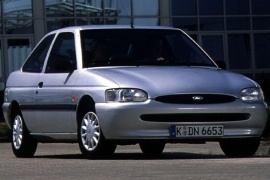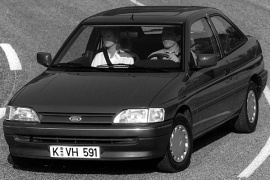
FORD Escort 3 Doors
Generations Timeline, Specs and Pictures

Ford introduced the sixth generation of the Escort in 1995, but the car was so similar to the fifth generation that it took a keen eye to see the differences.
There was a new design trend on the market that focused on curved lines and rounded edges. Ford’s designers just took the fifth generation, made some subtle modifications here and there, and the car was done. It looked better, trendier, but not too different than its predecessor. But Ford needed a new vehicle in the fast-growing compact segment, and the three-door version was the one that offered the sporty-look for the younger generation.
For the 1995 Escort, Ford introduced a new front fascia with smaller headlights rounded on the inbound side. The oval grille was kept from its predecessor, but the bumper featured a rounded, slim opening to cool the engine. Depending on the trim-level and the options, the 1995 Escort featured headlights washers, but the base model featured black plastic bumpers. From the sides, the squared-shape of the door handles was changed in favor of rounded ones.
Inside, a newly designed dashboard took the place of the older, squared one. Its instrument cluster was extended over the center stack and the central vents. The radio-cassette was included in the standard version, but the power windows and mirrors didn’t. At least, it featured a driver’s airbag and power-steering. In the back, the folding and tilting bench was standard as well.
Under the hood, Ford kept the 1.4-liter engine for the base model, but its entire lineup was with fuel injection. Three diesel engines were introduced to cover the demand for commuter cars. For those looking for a hot-hatch, Ford offered the 2000RS version with a naturally-aspirated 2.0-liter, fuel-injected engine that provided 150 hp.

The fifth generation of the Escort was a car built for common families and enthusiasts.
While the former usually went for other body styles, the latter fell for the coupe.
By 1990, it was already common to name a coupe any hatchback with three doors, and the market started to be used to that. The Escort was no exception, but at least it tried to have a coupe-style profile and offered the vehicle with sportier engines and improved suspension.
The Escort featured a mixed design, between the boxy-looking vehicles of the ’80s and the flowing lines of the ’90s. While the headlights and the grille with sharp, horizontal slats were still a thing of the past, the rest of the car looked into the future with curved body panels and some horizontal lines across the car from headlights to taillights. A sloped tailgate was ended into a very short deck, inspiring a two and a half body design.
The interior was similar to the one from the five-door version. The tachometer was not fitted as standard on every engine version. Like its siblings, the Escort 3-doors was fitted with a few fuel-efficient engines, built mainly as a commuter car. There was limited room in the back, but enough in the front, even for taller occupants.
Ford installed a wide range of engines in the engine bay, starting with a lazy, but fuel-efficient, 60 hp engine, but gained on the sportiness with the 2.0i version that offered 150 hp.

Ford introduced the third generation of the Escort in 1980, and it was available in a few body shapes, including a three-door version.
It was the most significant change for the compact-sized vehicle built by Ford in Europe. The design team started with a blank sheet of paper. Unlike its predecessor, the new Escort had to be front-wheel-drive. It was the second FWD car built by the European branch of the American carmaker. The other one was the first-generation Fiesta.
Patrick Le Quement started the work for the Escort range in 1976 and imagined it with straight lines and a wedged shape. He tried to move over from the older version’s flowing lines to a hatchback design, a trend that grew since the launch of the VW Golf in 1974. Unlike its German competitor, the Escort featured rectangular headlights and a very short decklid behind the rear window. For the three-door version, the design team made fixed rear side windows and longer doors.
Inside, the straight-lines design with rounded corners. Soft materials were added to the contact surfaces, such as the door’s armrests. Depending on the trim level and engine version, the carmaker installed a tachometer in the instrument cluster or not. The top-of-the-line XR3 featured a center console used for the stereo-cassette player, an ashtray, and a storage compartment.
Ford installed a wide range of engines under the hood, including a turbocharged gasoline unit that offered 132 hp, and it was way faster than its main rival, the Golf GTI. But the reliability issues made the other German sells better.























































